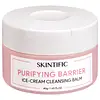What's inside
What's inside
 Key Ingredients
Key Ingredients

 Benefits
Benefits

 Concerns
Concerns

 Ingredients Side-by-side
Ingredients Side-by-side

Ethylhexyl Palmitate
EmollientCetyl Ethylhexanoate
EmollientPEG-20 Glyceryl Triisostearate
EmollientCaprylic/Capric Triglyceride
MaskingSynthetic Wax
AbrasivePolyglyceryl-6 Dicaprate
EmulsifyingPEG-8 Glyceryl Isostearate
EmollientWater
Skin ConditioningMicrocrystalline Wax
Emulsion StabilisingSilica
AbrasivePhenoxyethanol
PreservativeTriethyl Citrate
MaskingEthoxydiglycol
HumectantPolyglyceryl-2 Triisostearate
EmulsifyingCharcoal Powder
AbrasiveLavandula Angustifolia Oil
MaskingRosmarinus Officinalis Leaf Oil
MaskingJuniperus Virginiana Oil
MaskingPelargonium Graveolens Oil
MaskingPanthenol
Skin ConditioningTocopheryl Acetate
AntioxidantButylene Glycol
HumectantDipteryx Odorata Bean Extract
MaskingPolianthes Tuberosa Extract
MaskingCynara Scolymus Leaf Extract
Skin ConditioningEthylhexyl Palmitate, Cetyl Ethylhexanoate, PEG-20 Glyceryl Triisostearate, Caprylic/Capric Triglyceride, Synthetic Wax, Polyglyceryl-6 Dicaprate, PEG-8 Glyceryl Isostearate, Water, Microcrystalline Wax, Silica, Phenoxyethanol, Triethyl Citrate, Ethoxydiglycol, Polyglyceryl-2 Triisostearate, Charcoal Powder, Lavandula Angustifolia Oil, Rosmarinus Officinalis Leaf Oil, Juniperus Virginiana Oil, Pelargonium Graveolens Oil, Panthenol, Tocopheryl Acetate, Butylene Glycol, Dipteryx Odorata Bean Extract, Polianthes Tuberosa Extract, Cynara Scolymus Leaf Extract
Ethylhexyl Palmitate
EmollientCaprylic/Capric Triglyceride
MaskingPEG-20 Glyceryl Triisostearate
EmollientSynthetic Wax
AbrasiveButylene Glycol
HumectantCera Microcristallina
Emulsion StabilisingFragaria Chiloensis Fruit Extract
Skin ConditioningEuterpe Oleracea Fruit Extract
Rubus Fruticosus Fruit Extract
AstringentCentella Asiatica Extract
CleansingCeramide NP
Skin ConditioningCeramide EOP
Skin ConditioningCeramide Ns
Skin ConditioningCeramide As
Skin ConditioningCeramide AP
Skin ConditioningAscorbic Acid
AntioxidantTocopherol
AntioxidantHydrogenated Lecithin
EmulsifyingCyclodextrin
AbsorbentGlycerin
HumectantEthylhexylglycerin
Skin ConditioningWater
Skin ConditioningEthylhexyl Palmitate, Caprylic/Capric Triglyceride, PEG-20 Glyceryl Triisostearate, Synthetic Wax, Butylene Glycol, Cera Microcristallina, Fragaria Chiloensis Fruit Extract, Euterpe Oleracea Fruit Extract, Rubus Fruticosus Fruit Extract, Centella Asiatica Extract, Ceramide NP, Ceramide EOP, Ceramide Ns, Ceramide As, Ceramide AP, Ascorbic Acid, Tocopherol, Hydrogenated Lecithin, Cyclodextrin, Glycerin, Ethylhexylglycerin, Water
 Reviews
Reviews

Ingredients Explained
These ingredients are found in both products.
Ingredients higher up in an ingredient list are typically present in a larger amount.
Butylene Glycol (or BG) is used within cosmetic products for a few different reasons:
Overall, Butylene Glycol is a safe and well-rounded ingredient that works well with other ingredients.
Though this ingredient works well with most skin types, some people with sensitive skin may experience a reaction such as allergic rashes, closed comedones, or itchiness.
Learn more about Butylene GlycolThis ingredient is an emollient, solvent, and texture enhancer. It is considered a skin-softener by helping the skin prevent moisture loss.
It helps thicken a product's formula and makes it easier to spread by dissolving clumping compounds.
Caprylic Triglyceride is made by combining glycerin with coconut oil, forming a clear liquid.
While there is an assumption Caprylic Triglyceride can clog pores due to it being derived from coconut oil, there is no research supporting this.
Learn more about Caprylic/Capric TriglycerideEthylhexyl Palmitate, also known as octyl palmitate, is created from 2-ethylhexyl alcohol and palmitic acid. It is a fatty acid ester.
The fatty acid content of Ethylhexyl Palmitate makes it an emollient. Emollients help soften and hydrate your skin by trapping moisture within.
Ethylhexyl Palmitate is also used to help improve the texture of cosmetics. It helps other ingredient dissolve in products and help disperse ingredients more evenly.
You'll likely find this ingredient in sunscreen, as it is often used to mix UV-blocking ingredients such as avobenzone and ethylhexyl triazone.
It can also help stabilize the fragrances in a product as a fragrance fixative.
Ethylhexyl Palmitate can be used to substitute mineral oil.
Due to its high fatty acid content, it may not be fungal-acne safe.
Learn more about Ethylhexyl PalmitatePeg-20 Glyceryl Triisostearate comes from Isostearic Acid and glycerin.
It is an emollient, emulsifier, and gentle cleanser. As an emollient, it helps trap moisture to keep skin soft and hydrated. Emulsifiers help prevent ingredients from separating.
This ingredient is common in oil-based products. This is because it helps oil-ingredients be easily washed away without leaving a residue.
Peg-20 Glyceryl Triisostearate may not be fungal-acne safe.
Learn more about PEG-20 Glyceryl TriisostearateSynthetic Wax is created from fossil fuels such as natural gas. It is used to enhance texture, adjust pH, and as an occlusive.
It may also be used as an abrasive ingredient to exfoliate the skin.
Synthetic Wax may not be fungal acne safe.
Learn more about Synthetic WaxWater. It's the most common cosmetic ingredient of all. You'll usually see it at the top of ingredient lists, meaning that it makes up the largest part of the product.
So why is it so popular? Water most often acts as a solvent - this means that it helps dissolve other ingredients into the formulation.
You'll also recognize water as that liquid we all need to stay alive. If you see this, drink a glass of water. Stay hydrated!
Learn more about Water